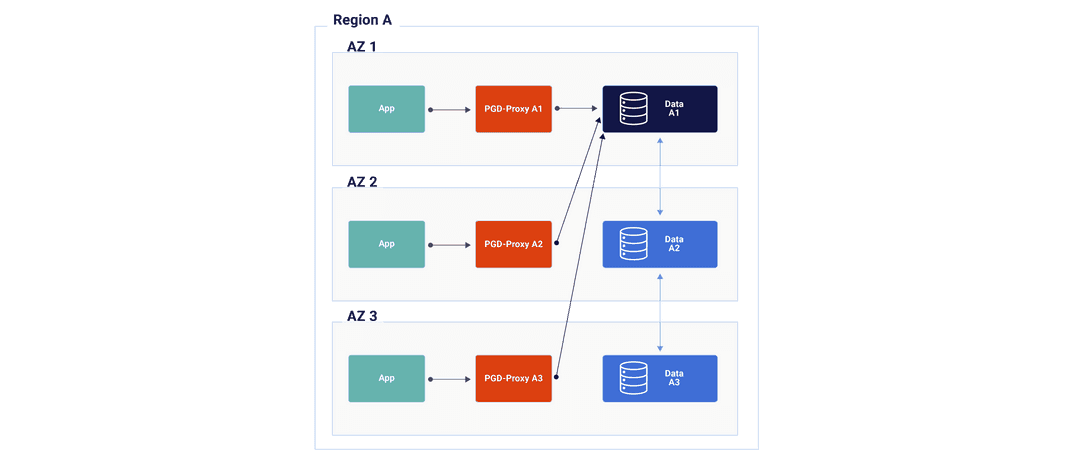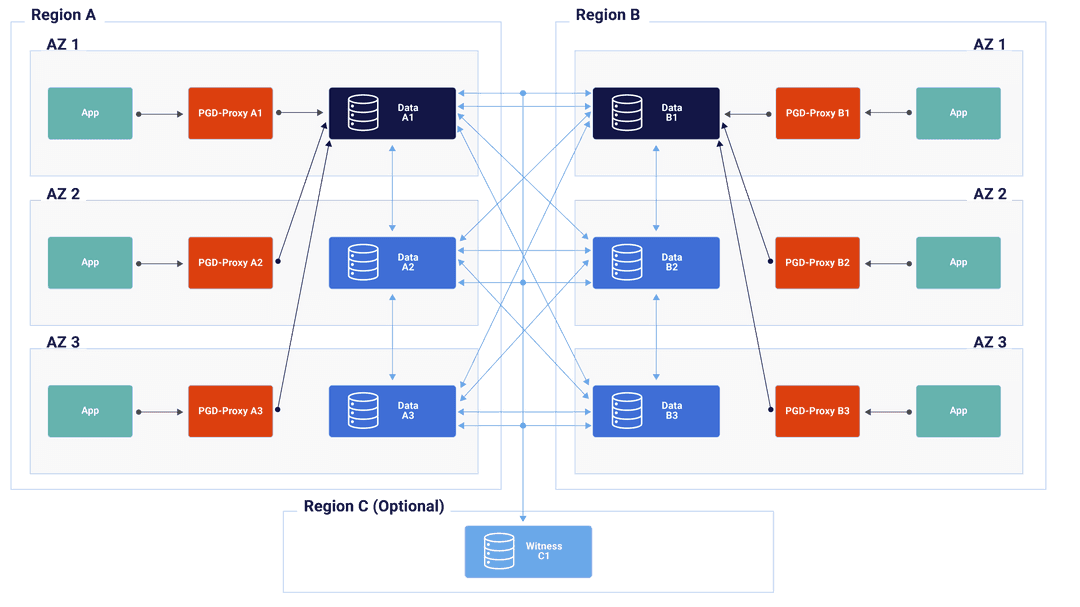Choosing your architecture v5.6
Always-on architectures reflect EDB’s Trusted Postgres architectures. They encapsulate practices and help you to achieve the highest possible service availability in multiple configurations. These configurations range from single-location architectures to complex distributed systems that protect from hardware failures and data center failures. The architectures leverage EDB Postgres Distributed’s multi-master capability and its ability to achieve 99.999% availability, even during maintenance operations.
You can use EDB Postgres Distributed for architectures beyond the examples described here. Use-case-specific variations have been successfully deployed in production. However, these variations must undergo rigorous architecture review first.
Always-on architectures can be deployed using EDB’s standard deployment tool
Trusted Postgres Architect (TPA) or configured manually.
Standard EDB Always-on architectures
EDB has identified a set of standardized architectures to support single- or multi-location deployments with varying levels of redundancy, depending on your recovery point objective (RPO) and recovery time objective (RTO) requirements.
The Always-on architecture uses three database node groups as a basic building block. You can also use a five-node group for extra redundancy.
EDB Postgres Distributed consists of the following major building blocks:
- Bi-Directional Replication (BDR) — A Postgres extension that creates the multi-master mesh network
- PGD Proxy — A connection router that makes sure the application is connected to the right data nodes.
All Always-on architectures protect an increasing range of failure situations. For example, a single active location with two data nodes protects against local hardware failure but doesn't provide protection from location (data center or availability zone) failure. Extending that architecture with a backup at a different location ensures some protection in case of the catastrophic loss of a location. However, you still must restore the database from backup first, which might violate RTO requirements. Adding a second active location connected in a multi-master mesh network ensures that service remains available even if a location goes offline. Finally, adding a third location (this can be a witness-only location) allows global Raft functionality to work even if one location goes offline. The global Raft is primarily needed to run administrative commands. Also, some features like DDL or sequence allocation might not work without it, while DML replication can continue to work even without global Raft.
Each architecture can provide zero RPO, as data can be streamed synchronously to at least one local master, guaranteeing zero data loss in case of local hardware failure.
Increasing the availability guarantee always drives added cost for hardware and licenses, networking requirements, and operational complexity. It's important to carefully consider the availability and compliance requirements before choosing an architecture.
Architecture details
By default, application transactions don't require cluster-wide consensus for DML (selects, inserts, updates, and deletes), allowing for lower latency and better performance. However, for certain operations, such as generating new global sequences or performing distributed DDL, EDB Postgres Distributed requires an odd number of nodes to make decisions using a Raft-based consensus model. Thus, even the simpler architectures always have three nodes, even if not all of them are storing data.
Applications connect to the standard Always-on architectures by way of multi-host connection strings, where each PGD Proxy server is a distinct entry in the multi-host connection string. You must always have at least two proxy nodes in each location to ensure high availability. You can colocate the proxy with the database instance, in which case we recommend putting the proxy on every data node.
Other connection mechanisms have been successfully deployed in production. However, they aren't part of the standard Always-on architectures.
Always-on Single Location

- Additional replication between data nodes 1 and 3 isn't shown but occurs as part of the replication mesh
- Redundant hardware to quickly restore from local failures
- 3 PGD nodes
- Can be 3 data nodes (recommended)
- Can be 2 data nodes and 1 witness that doesn't hold data (not depicted)
- A PGD Proxy for each data node with affinity to the applications
- Can be colocated with data node (recommended)
- Can be located on a separate node
- Configuration and infrastructure symmetry of data nodes is expected to ensure proper resources are available to handle application workload when rerouted
- 3 PGD nodes
- Barman for backup and recovery (not depicted)
- Offsite is optional but recommended
- Can be shared by multiple PGD clusters
- Postgres Enterprise Manager (PEM) for monitoring (not depicted)
- Can be shared by multiple PGD clusters
Always-on Multi-location

- Application can be Active/Active in each location or can be Active/Passive or Active DR with only one location taking writes.
- Additional replication between data nodes 1 and 3 isn't shown but occurs as part of the replication mesh.
- Redundant hardware to quickly restore from local failures.
- 6 PGD nodes total, 3 in each location
- Can be 3 data nodes (recommended)
- Can be 2 data nodes and 1 witness which does not hold data (not depicted)
- A PGD Proxy for each data node with affinity to the applications
- Can be colocated with data node (recommended)
- Can be located on a separate node
- Configuration and infrastructure symmetry of data nodes and locations is expected to ensure proper resources are available to handle application workload when rerouted
- 6 PGD nodes total, 3 in each location
- Barman for backup and recovery (not depicted).
- Can be shared by multiple PGD clusters
- Postgres Enterprise Manager (PEM) for monitoring (not depicted).
- Can be shared by multiple PGD clusters
- An optional witness node must be placed in a third region to increase tolerance for location failure.
- Otherwise, when a location fails, actions requiring global consensus are blocked, such as adding new nodes and distributed DDL.
Choosing your architecture
All architectures provide the following:
- Hardware failure protection
- Zero downtime upgrades
- Support for availability zones in public/private cloud
Use these criteria to help you to select the appropriate Always-on architecture.
| Single-data location | Two data locations | Two data locations + witness | Three or more data locations | |
|---|---|---|---|---|
| Locations needed | 1 | 2 | 3 | 3 |
| Fast restoration of local HA after data node failure | Yes - if 3 PGD data nodes No - if 2 PGD data nodes | Yes - if 3 PGD data nodes No - if 2 PGD data nodes | Yes - if 3 PGD data nodes No - if 2 PGD data nodes | Yes - if 3 PGD data nodes No - if 2 PGD data nodes |
| Data protection in case of location failure | No (unless offsite backup) | Yes | Yes | Yes |
| Global consensus in case of location failure | N/A | No | Yes | Yes |
| Data restore required after location failure | Yes | No | No | No |
| Immediate failover in case of location failure | No - requires data restore from backup | Yes - alternate Location | Yes - alternate Location | Yes - alternate Location |
| Cross-location network traffic | Only if backup is offsite | Full replication traffic | Full replication traffic | Full replication traffic |
| License cost | 2 or 3 PGD data nodes | 4 or 6 PGD data nodes | 4 or 6 PGD data nodes | 6+ PGD data nodes |
Adding flexibility to the standard architectures
To provide the data resiliency needed and proximity to applications and to the users maintaining the data, you can deploy the single-location architecture in as many locations as you want. While EDB Postgres Distributed has a variety of conflict-handling approaches available, do take care to minimize the number of expected collisions if allowing write activity from geographically disparate locations.
You can also expand the standard architectures with two additional types of nodes:
Subscriber-only nodes, which you can use to achieve additional read scalability and to have data closer to users when the majority of an application’s workload is read intensive with infrequent writes. You can also leverage them to publish a subset of the data for reporting, archiving, and analytic needs.
Logical standbys, which receive replicated data from another node in the PGD cluster but don't participate in the replication mesh or consensus. They contain all the same data as the other PGD data nodes and can quickly be promoted to a master if one of the data nodes fails to return the cluster to full capacity/consensus. You can use them in environments where network traffic between data centers is a concern. Otherwise, three PGD data nodes per location is always preferred.